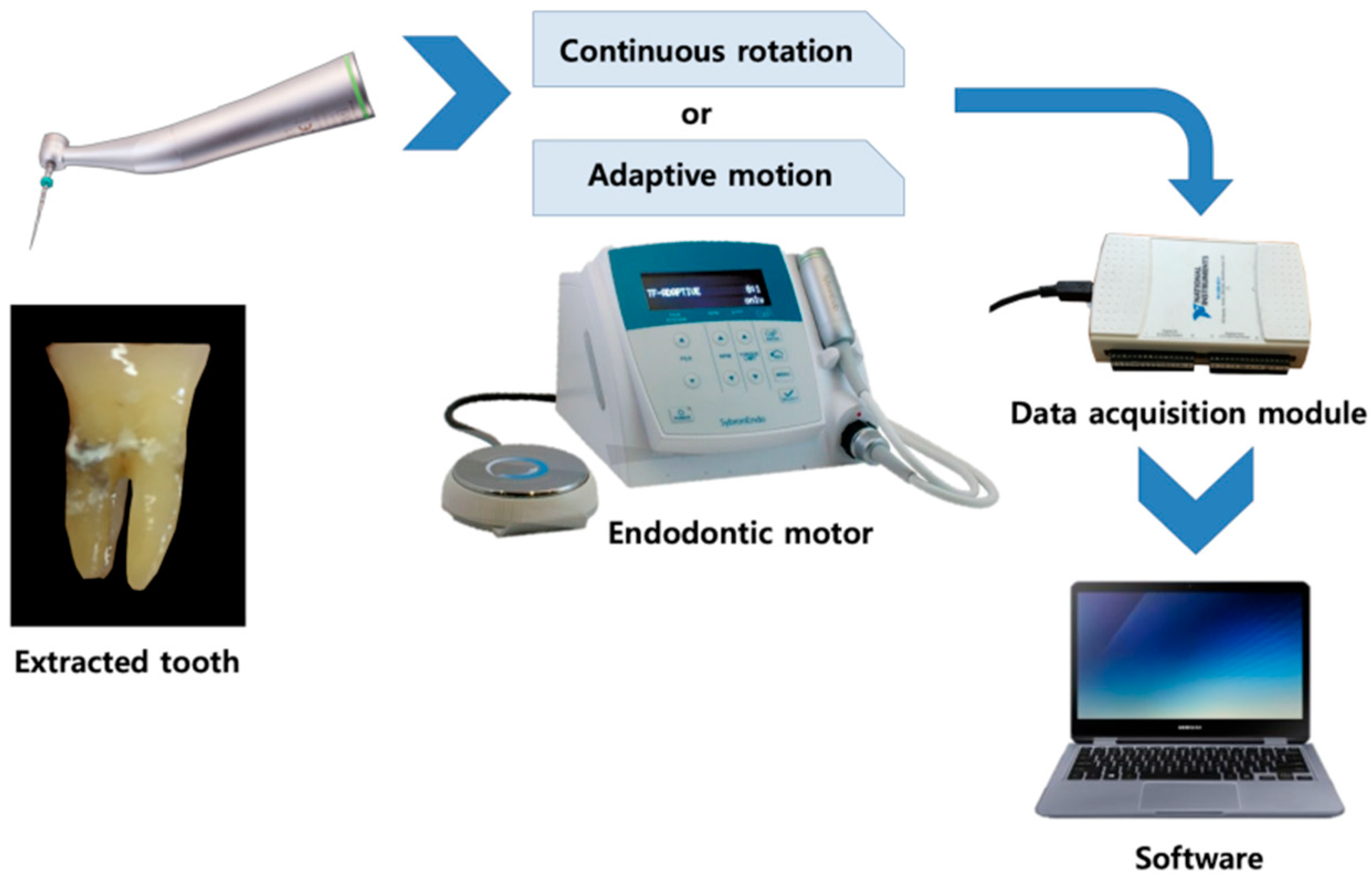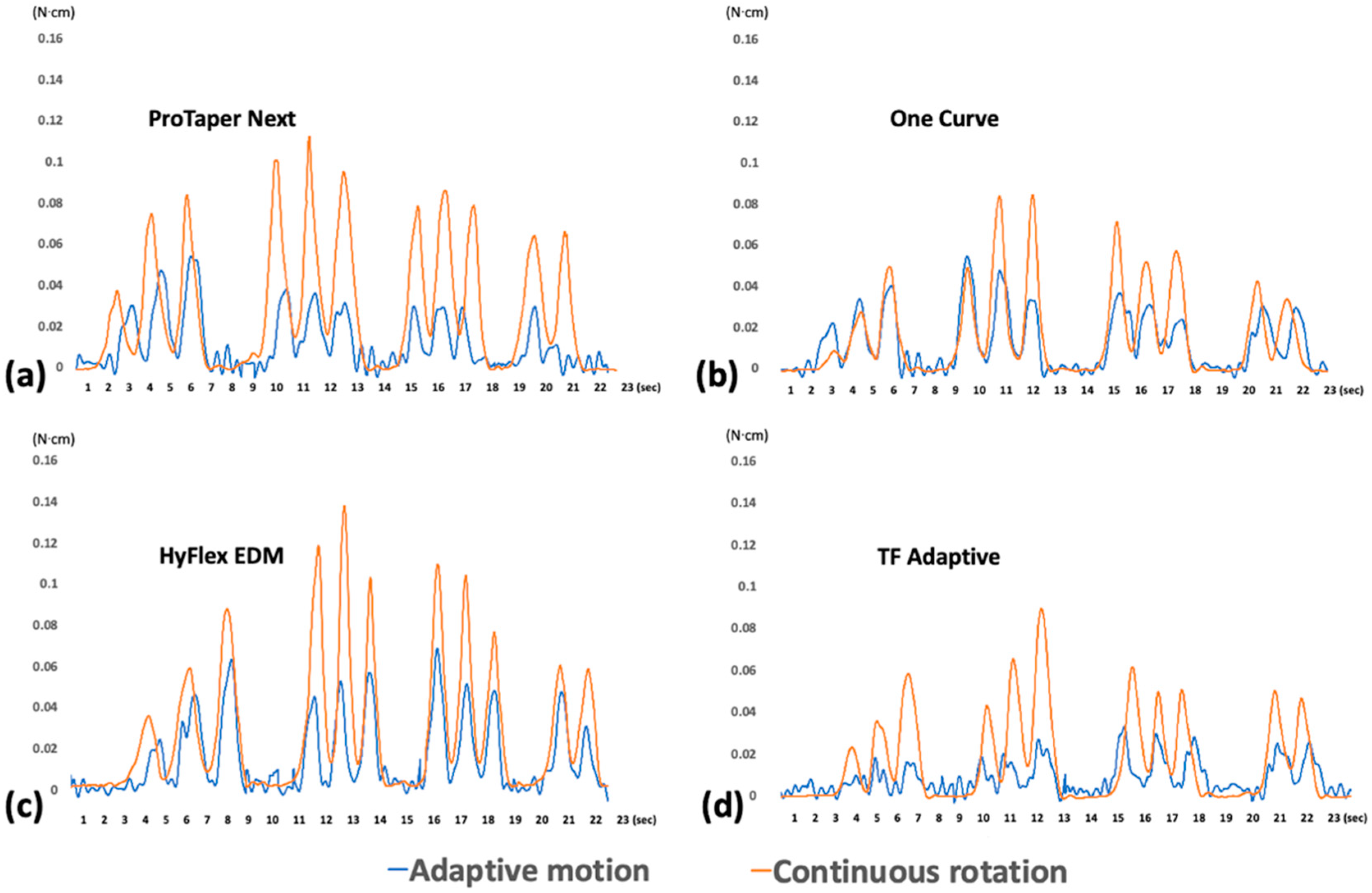Ex-Vivo Comparison of Torsional Stress on Nickel–Titanium Instruments Activated by Continuous Rotation or Adaptive Motion
Abstract
1. Introduction
2. Materials and Methods
2.1. Instrument Selection
2.2. Tooth Preparation
2.3. Torsional Load Measurement
2.4. Statistical Analysis
3. Results
3.1. Total Torsional Load
3.2. Maximum Torque
4. Discussion
5. Conclusions
Author Contributions
Funding
Conflicts of Interest
References
- Cheung, G.S.; Liu, C.S. A Retrospective Study of Endodontic Treatment Outcome between Nickel-Titanium Rotary and Stainless Steel Hand Filing Techniques. J. Endod. 2009, 35, 938–943. [Google Scholar] [CrossRef] [PubMed]
- Schäfer, E.; Bürklein, S. Impact of nickel–titanium instrumentation of the root canal on clinical outcomes: A focused review. Odontology 2012, 100, 130–136. [Google Scholar] [CrossRef] [PubMed]
- Gil, J.; Rupérez, E.; Velasco, E.; Aparicio, C.; Manero, J.M. Mechanism of fracture of NiTi superelastic endodontic rotary instruments. J. Mater. Sci. Mater. Electron. 2018, 29, 131. [Google Scholar] [CrossRef] [PubMed]
- Tan, B.T.; Messer, H.H. The Quality of Apical Canal Preparation Using Hand and Rotary Instruments with Specific Criteria for Enlargement Based on Initial Apical File Size. J. Endod. 2002, 28, 658–664. [Google Scholar] [CrossRef] [PubMed]
- Ha, J.-H.; Park, S.-S. Influence of glide path on the screw-in effect and torque of nickel-titanium rotary files in simulated resin root canals. Restor. Dent. Endod. 2012, 37, 215–219. [Google Scholar] [CrossRef] [PubMed]
- Ha, J.-H.; Kwak, S.W.; Kim, S.K.; Kim, H.-C. Screw-in forces during instrumentation by various file systems. Restor. Dent. Endod. 2016, 41, 304–309. [Google Scholar] [CrossRef]
- Ha, J.-H.; Kwak, S.W.; Sigurdsson, A.; Chang, S.W.; Kim, S.K.; Kim, H.-C. Stress Generation during Pecking Motion of Rotary Nickel-titanium Instruments with Different Pecking Depth. J. Endod. 2017, 43, 1688–1691. [Google Scholar] [CrossRef]
- Tokita, D.; Ebihara, A.; Nishijo, M.; Miyara, K.; Okiji, T. Dynamic Torque and Vertical Force Analysis during Nickel-titanium Rotary Root Canal Preparation with Different Modes of Reciprocal Rotation. J. Endod. 2017, 43, 1706–1710. [Google Scholar] [CrossRef]
- Cheung, G.S. Instrument fracture: Mechanisms, removal of fragments, and clinical outcomes. Endod. Top. 2007, 16, 1–26. [Google Scholar] [CrossRef]
- Tokita, D.; Ebihara, A.; Miyara, K.; Okiji, T. Dynamic Torsional and Cyclic Fracture Behavior of ProFile Rotary Instruments at Continuous or Reciprocating Rotation as Visualized with High-speed Digital Video Imaging. J. Endod. 2017, 43, 1337–1342. [Google Scholar] [CrossRef]
- Tripi, T.R.; Bonaccorso, A.; Condorelli, G.G. Cyclic fatigue of different nickel-titanium endodontic rotary instruments. Oral Surg. Oral Med. Oral Pathol. Oral Radiol. Endod. 2006, 102, e106–e114. [Google Scholar] [CrossRef] [PubMed]
- Yum, J.; Cheung, G.S.-P.; Park, J.-K.; Hur, B.; Kim, H.-C. Torsional Strength and Toughness of Nickel-Titanium Rotary Files. J. Endod. 2011, 37, 382–386. [Google Scholar] [CrossRef] [PubMed]
- Park, S.-Y.; Cheung, G.S.P.; Yum, J.; Hur, B.; Park, J.-K.; Kim, H.-C. Dynamic Torsional Resistance of Nickel-Titanium Rotary Instruments. J. Endod. 2010, 36, 1200–1204. [Google Scholar] [CrossRef] [PubMed]
- Ha, J.-H.; Kim, S.K.; Cohenca, N.; Kim, H.-C. Effect of R-phase Heat Treatment on Torsional Resistance and Cyclic Fatigue Fracture. J. Endod. 2013, 39, 389–393. [Google Scholar] [CrossRef] [PubMed]
- Ha, J.-H.; Kim, S.K.; Cheung, G.S.-P.; Jeong, S.H.; Bae, Y.C.; Kim, H.-C. Effect of alloy type on the life-time of torsion-preloaded nickel-titanium endodontic instruments. Scanning 2015, 37, 172–178. [Google Scholar] [CrossRef]
- Baek, S.-H.; Lee, C.-J.; Versluis, A.; Kim, B.-M.; Lee, W.; Kim, H.-C. Comparison of Torsional Stiffness of Nickel-Titanium Rotary Files with Different Geometric Characteristics. J. Endod. 2011, 37, 1283–1286. [Google Scholar] [CrossRef]
- Kim, H.C.; Kim, H.J.; Lee, C.J.; Kim, B.M.; Park, J.K.; Versluis, A. Mechanical response of nickel-titanium instruments with different cross-sectional designs during shaping of simulated curved canals. Int. Endod. J. 2009, 42, 593–602. [Google Scholar] [CrossRef]
- Kwak, S.W.; Ha, J.-H.; Cheung, G.S.-P.; Kim, S.K.; Kim, H.-C. Comparison of In Vitro Torque Generation during Instrumentation with Adaptive Versus Continuous Movement. J. Endod. 2019, 45, 803–807. [Google Scholar] [CrossRef]
- Bueno, C.S.P.; De Oliveira, D.P.; Pelegrine, R.A.; Fontana, C.E.; Rocha, D.G.P.; Bueno, C.E.D.S. Fracture Incidence of WaveOne and Reciproc Files during Root Canal Preparation of up to 3 Posterior Teeth: A Prospective Clinical Study. J. Endod. 2017, 43, 705–708. [Google Scholar] [CrossRef]
- You, S.-Y.; Bae, K.-S.; Baek, S.-H.; Kum, K.-Y.; Shon, W.-J.; Lee, W. Lifespan of One Nickel-Titanium Rotary File with Reciprocating Motion in Curved Root Canals. J. Endod. 2010, 36, 1991–1994. [Google Scholar] [CrossRef]
- Kansal, R.; Rajput, A.; Talwar, S.; Roongta, R.; Verma, M. Assessment of Dentinal Damage during Canal Preparation Using Reciprocating and Rotary Files. J. Endod. 2014, 40, 1443–1446. [Google Scholar] [CrossRef] [PubMed]
- Yared, G. Canal preparation using only one Ni-Ti rotary instrument: Preliminary observations. Int. Endod. J. 2008, 41, 339–344. [Google Scholar] [CrossRef] [PubMed]
- Koçak, S.; Koçak, M.M.; Sağlam, B.C.; Türker, S.A.; Sağsen, B.; Er, Ö. Apical Extrusion of Debris Using Self-Adjusting File, Reciprocating Single-file, and 2 Rotary Instrumentation Systems. J. Endod. 2013, 39, 1278–1280. [Google Scholar] [CrossRef]
- Bürklein, S.; Benten, S.; Schäfer, E. Quantitative evaluation of apically extruded debris with different single-file systems: Reciproc, F360 and OneShape versus Mtwo. Int. Endod. J. 2013, 47, 405–409. [Google Scholar] [CrossRef] [PubMed]
- Franco, V.; Fabiani, C.; Taschieri, S.; Malentacca, A.; Bortolin, M.; Del Fabbro, M. Investigation on the Shaping Ability of Nickel-Titanium Files When Used with a Reciprocating Motion. J. Endod. 2011, 37, 1398–1401. [Google Scholar] [CrossRef]
- Ordinola-Zapata, R.; Bramante, C.M.; Duarte, M.A.H.; Cavenago, B.C.; Jaramillo, D.; Versiani, M.A. Shaping ability of Reciproc and TF Adaptive systems in severely curved canals of rapid microCT-based prototyping molar replicas. J. Appl. Oral Sci. 2014, 22, 509–515. [Google Scholar] [CrossRef]
- Gambarini, G.; Al Sudani, D.; Di Carlo, S.; Pompa, G.; Pacifici, A.; Pacifici, L.; Testarelli, L. Incidence and Intensivity of Postoperative Pain and Periapical Inflammation after Endodontic Treatment with Two Different Instrumentation Techniques. Eur. J. Inflamm. 2012, 10, 99–103. [Google Scholar] [CrossRef]
- Gambarini, G.; Glassman, G. In vitro analysis of efficiency and safety of a new motion for endodontic instrumentation: TF Adapt. Roots 2013, 3, 12–15. [Google Scholar]
- Kim, H.-C.; Cheung, G.S.-P.; Lee, C.; Kim, B.-M.; Park, J.-K.; Kang, S.-I. Comparison of Forces Generated During Root Canal Shaping and Residual Stresses of Three Nickel–Titanium Rotary Files by Using a Three-Dimensional Finite-element Analysis. J. Endod. 2008, 34, 743–747. [Google Scholar] [CrossRef]
- Kim, H.-J.; Lee, C.-J.; Kim, B.-M.; Park, J.-K.; Hur, B.; Kim, H.-C. Stress distribution for NiTi files of triangular based and rectangular based cross-sections using 3-dimensional finite element analysis. J. Korean Acad. Conserv. Dent. 2009, 34, 1–7. [Google Scholar] [CrossRef]
- Kim, H.-C.; Lee, M.-H.; Yum, J.; Versluis, A.; Lee, C.; Kim, B.-M. Potential Relationship between Design of Nickel-Titanium Rotary Instruments and Vertical Root Fracture. J. Endod. 2010, 36, 1195–1199. [Google Scholar] [CrossRef] [PubMed]
- Kwak, S.W.; Ha, J.-H.; Cheung, G.S.-P.; Kim, H.-C.; Kim, S.K. Effect of the Glide Path Establishment on the Torque Generation to the Files during Instrumentation: An In Vitro Measurement. J. Endod. 2018, 44, 496–500. [Google Scholar] [CrossRef] [PubMed]
- Dane, A.; Çapar, I.D.; Arslan, H.; Akcay, M.; Uysal, B.; Dane, A.; Information, P.E.K.F.C. Effect of Different Torque Settings on Crack Formation in Root Dentin. J. Endod. 2016, 42, 304–306. [Google Scholar] [CrossRef] [PubMed]
- Gambarini, G. Rationale for the use of low-torque endodontic motors in root canal instrumentation. Endod. Dent. Traumatol. 2000, 16, 95–100. [Google Scholar] [CrossRef]
- Shen, Y.; Zhou, H.-M.; Zheng, Y.; Peng, B.; Haapasalo, M. Current Challenges and Concepts of the Thermomechanical Treatment of Nickel-Titanium Instruments. J. Endod. 2013, 39, 163–172. [Google Scholar] [CrossRef]
- Iacono, F.; Pirani, C.; Generali, L.; Bolelli, G.; Sassatelli, P.; Lusvarghi, L.; Gandolfi, M.; Giorgini, L.; Prati, C. Structural analysis of HyFlex EDM instruments. Int. Endod. J. 2016, 50, 303–313. [Google Scholar] [CrossRef]
- Kurt, S.M.; Kaval, M.E.; Serefoglu, B.; Demirci, G.K.; Çalışkan, M.K. Cyclic fatigue resistance and energy dispersive X-ray spectroscopy analysis of novel heat-treated nickel-titanium instruments at body temperature. Microsc. Res. Tech. 2020, in press. [Google Scholar] [CrossRef]


| File | Manufacturer | Specification | Recommended Rotation Speed (rpm) and Torque (gcm) | |||
|---|---|---|---|---|---|---|
| Cross-Section | Taper | Wire | rpm | gcm | ||
| ProTaper Next | Dentsply Sirona, Ballaigues, Switzerland | off-centered rectangle | Apical .06 and variable | M-wire | 300 | 200 |
| One Curve | Micro-Mega, Besançon, France | Variable | .06 | C-wire | 300 | 250 |
| HyFlex EDM | Coltene-Whaledent, Allstetten, Switzerland | Variable | Apical .08 and variable | CM-wire | 400 | 250 |
| Twisted File Adaptive | Kerr Endodontics, Orange, CA, USA | Triangle | .06 | R-phase | 500 | 200 |
| File | Maximum Torque (N·cm) * | Total Torsional Load (N·cm) * | ||
|---|---|---|---|---|
| Continuous Rotation | Adaptive Motion | Continuous Rotation | Adaptive Motion | |
| ProTaper Next | 0.092 ab | 0.042 b | 0.523 b | 0.214 ab |
| One Curve | 0.106 bc | 0.046 b | 0.471 b | 0.230 bc |
| HyFlex EDM | 0.184 0.125 d | 0.059 0.012 c | 0.741 0.439 c | 0.218 0.066 ab |
| TF Adaptive | 0.048 0.025 a | 0.033 a | 0.185 0.045 a | 0.172 a |
© 2020 by the authors. Licensee MDPI, Basel, Switzerland. This article is an open access article distributed under the terms and conditions of the Creative Commons Attribution (CC BY) license (http://creativecommons.org/licenses/by/4.0/).
Share and Cite
Lee, J.Y.; Kwak, S.W.; Ha, J.-H.; Kim, H.-C. Ex-Vivo Comparison of Torsional Stress on Nickel–Titanium Instruments Activated by Continuous Rotation or Adaptive Motion. Materials 2020, 13, 1900. https://doi.org/10.3390/ma13081900
Lee JY, Kwak SW, Ha J-H, Kim H-C. Ex-Vivo Comparison of Torsional Stress on Nickel–Titanium Instruments Activated by Continuous Rotation or Adaptive Motion. Materials. 2020; 13(8):1900. https://doi.org/10.3390/ma13081900
Chicago/Turabian StyleLee, Joo Yeong, Sang Won Kwak, Jung-Hong Ha, and Hyeon-Cheol Kim. 2020. "Ex-Vivo Comparison of Torsional Stress on Nickel–Titanium Instruments Activated by Continuous Rotation or Adaptive Motion" Materials 13, no. 8: 1900. https://doi.org/10.3390/ma13081900
APA StyleLee, J. Y., Kwak, S. W., Ha, J.-H., & Kim, H.-C. (2020). Ex-Vivo Comparison of Torsional Stress on Nickel–Titanium Instruments Activated by Continuous Rotation or Adaptive Motion. Materials, 13(8), 1900. https://doi.org/10.3390/ma13081900






